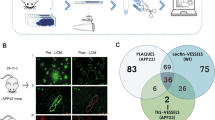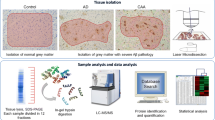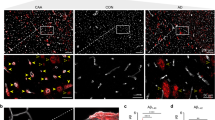Abstract
Sporadic cerebral amyloid angiopathy (CAA) is characterized by cerebrovascular amyloid beta (Aβ) deposits and causes cerebral hemorrhage and dementia. The exact molecules that co-accumulate with cerebrovascular Aβ deposits are still not fully known. In our study here, we performed proteomic analyses with microdissected leptomeningeal arteries and cerebral neocortical arterioles from 8 cases with severe CAA, 12 cases with mild CAA, and 10 control cases without CAA, and we determined the levels of highly expressed proteins in cerebral blood vessels in CAA. We focused on sushi repeat-containing protein 1 (SRPX1), which is specifically expressed in CAA-affected cerebral blood vessels. Because SRPX1, which is known as a tumor suppressor gene, reportedly induced apoptosis in tumor cells, we hypothesized that SRPX1 may play an important role in Aβ-induced apoptosis in CAA. Immunohistochemical studies revealed that SRPX1 co-accumulated with Aβ deposits in cerebral blood vessels of all autopsied cases with severe CAA. In contrast, no SRPX1 co-accumulated with Aβ deposits in senile plaques. Furthermore, we demonstrated that both Aβ40 and Aβ42 bound to SRPX1 in vitro and enhanced SRPX1 expression in primary cultures of cerebrovascular smooth muscle cells. SRPX1 enhanced caspase activity induced by Aβ40. Knockdown of SRPX1, in contrast, reduced the formation of Aβ40 accumulations and the activity of caspase in cultured cerebrovascular smooth muscle cells. SRPX1 may thus be a novel molecule that is up-regulated in cerebrovascular Aβ deposits and that may increase Aβ-induced cerebrovascular degeneration in CAA.





Similar content being viewed by others
Abbreviations
- AD:
-
Alzheimer’s disease
- Aβ:
-
Amyloid β
- ApoE:
-
Apolipoprotein E
- APP:
-
Amyloid precursor protein
- BSA:
-
Bovine serum albumin
- CAA:
-
Cerebral amyloid angiopathy
- CR:
-
Congo red
- ELISA:
-
Enzyme-linked immunosorbent assay
- HBSS:
-
Hanks’ balanced salt solution
- HSC-71:
-
Heat shock cognate 71 kDa protein
- HRP:
-
Horseradish peroxidase
- LCM:
-
Laser capture microdissection
- LC–MS/MS:
-
Liquid chromatography–tandem mass spectrometry
- PCR:
-
Polymerase chain reaction
- SAP:
-
Serum amyloid P component
- SRPX1:
-
Sushi repeat-containing protein 1
References
Biffi A, Sonni A, Anderson CD, Kissela B, Jagiella JM, Schmidt H et al (2010) Variants at APOE influence risk of deep and lobar intracerebral hemorrhage. Ann Neurol 68:934–943
Boulay AC, Saubaméa B, Declèves X, Cohen-Salmon M (2015) Purification of mouse brain vessels. J Vis Exp 105:e53208. doi:10.3791/53208
Braak H, Alafuzoff I, Arzberger T, Kretzschmar H, Del Tredici K (2006) Staging of Alzheimer disease-associated neurofibrillary pathology using paraffin sections and immunocytochemistry. Acta Neuropathol 112:389–404
Brenowitz WD, Nelson PT, Besser LM, Heller KB, Kukull WA (2015) Cerebral amyloid angiopathy and its co-occurrence with Alzheimer’s disease and other cerebrovascular neuropathologic changes. Neurobiol Aging 36:2702–2708
Butterfield DA, Lange ML (2009) Multifunctional roles of enolase in Alzheimer’s disease brain: beyond altered glucose metabolism. J Neurochem 111:915–933
Charidimou A, Martinez-Ramirez S, Shoamanesh A, Oliveira-Filho J, Frosch M, Vashkevich A et al (2015) Cerebral amyloid angiopathy with and without hemorrhage: evidence for different disease phenotypes. Neurology 84:1206–1212
Drummond E, Nayak S, Faustin A, Pires G, Hickman RA, Askenazi M et al (2017) Proteomic differences in amyloid plaques in rapidly progressive and sporadic Alzheimer’s disease. Acta Neuropathol. doi:10.1007/s00401-017-1691-0
Esiri MM, Wilcock GK (1986) Cerebral amyloid angiopathy in dementia and old age. J Neurol Neurosurg Psychiatry 49:1221–1226
Ferreira CS, Papamichael K, Guilbault G, Schwarzacher T, Gariepy J, Missailidis S (2008) DNA aptamers against the MUC1 tumour marker: design of aptamer-antibody sandwich ELISA for the early diagnosis of epithelial tumours. Anal Bioanal Chem 390:1039–1050
Gauthier SA, Sahoo S, Jung SS, Levy E (2012) Murine cerebrovascular cells as a cell culture model for cerebral amyloid angiopathy: isolation of smooth muscle and endothelial cells from mouse brain. Methods Mol Biol 849:261–274
Gioia L, Vogt LJ, Freeman WM, Flood A, Vogt BA, Vrana KE (1998) PCR-based apolipoprotein E genotype analysis from archival fixed brain. J Neurosci Methods 80:209–214
Head D, Bugg JM, Goate AM, Fagan AM, Mintun MA, Benzinger T et al (2012) Exercise engagement as a moderator of the effects of APOE genotype on amyloid deposition. Arch Neurol 69:636–643
HUGO Gene Nomenclature Committee (2017) Gene family: sushi domain containing. http://www.genenames.org/cgi-bin/genefamilies/set/1179. Accessed 20 Mar 2017
Kim CJ, Shimakage M, Kushima R, Mukaisho K, Shinka T, Okada Y et al (2003) Down-regulation of drs mRNA in human prostate carcinomas. Hum Pathol 34:654–657
Liao L, Cheng D, Wang J, Duong DM, Losik TG, Gearing M et al (2004) Proteomic characterization of postmortem amyloid plaques isolated by laser capture microdissection. J Biol Chem 279:37061–37068
Mandybur TI (1975) The incidence of cerebral amyloid angiopathy in Alzheimer’s disease. Neurology 25:120–126
Meindl A, Carvalho MR, Herrmann K, Lorenz B, Achatz H, Lorenz B et al (1995) A gene (SRPX) encoding a sushi-repeat-containing protein is deleted in patients with X-linked retinitis pigmentosa. Hum Mol Genet 4:2339–2346
Mirra SS, Heyman A, McKeel D, Sumi SM, Crain BJ, Brownlee LM et al (1991) The consortium to establish a registry for Alzheimer’s disease (CERAD): part II. Standardization of the neuropathologic assessment of Alzheimer’s disease. Neurology 41:479–486
Nakamura T, Shinriki S, Jono H, Guo J, Ueda M, Hayashi M et al (2015) Intrinsic TGF-β2-triggered SDF-1-CXCR4 signaling axis is crucial for drug resistance and a slow-cycling state in bone marrow-disseminated tumor cells. Oncotarget 6:1008–1019. doi:10.18632/oncotarget.2826
Olsson B, Lautner R, Andreasson U, Öhrfelt A, Portelius E, Bjerke M et al (2016) CSF and blood biomarkers for the diagnosis of Alzheimer’s disease: a systematic review and meta-analysis. Lancet Neurol 15:673–684
Paoletti AC, Parmely TJ, Tomomori-Sato C, Sato S, Zhu D, Conaway RC et al (2006) Quantitative proteomic analysis of distinct mammalian Mediator complexes using normalized spectral abundance factors. Proc Natl Acad Sci USA 103:18928–18933. doi:10.1073/pnas.0606379103
Pawłowski K, Muszewska A, Lenart A, Szczepińska T, Godzik A, Grynberg M (2010) A widespread peroxiredoxin-like domain present in tumor suppression- and progression-implicated proteins. BMC Genomics 11:590
Richards DB, Cookson LM, Berges AC, Barton SV, Lane T, Ritter JM et al (2015) Therapeutic clearance of amyloid by antibodies to serum amyloid P component. N Engl J Med 373:1106–1114. doi:10.1056/NEJMoa1504942
Sengüven B, Baris E, Oygur T, Berktas M (2014) Comparison of methods for the extraction of DNA from formalin-fixed, paraffin-embedded archival tissues. Int J Med Sci 11:494–499
Shimakage M, Kawahara K, Kikkawa N, Sasagawa T, Yutsudo M, Inoue H (2000) Down-regulation of drs mRNA in human colon adenocarcinomas. Int J Cancer 87:5–11
Tambe Y, Isono T, Haraguchi S, Yoshioka-Yamashita A, Yutsudo M, Inoue H (2004) A novel apoptotic pathway induced by the drs tumor suppressor gene. Oncogene 23:2977–2987. doi:10.1038/sj.onc.1207419
Tambe Y, Yoshioka-Yamashita A, Mukaisho K, Haraguchi S, Chano T, Isono T et al (2007) Tumor prone phenotype of mice deficient in a novel apoptosis-inducing gene, drs. Carcinogenesis 28:777–784. doi:10.1093/carcin/bgl211
Tasaki M, Ueda M, Obayashi K, Koike H, Kitagawa K, Ogi Y et al (2013) Effect of age and sex differences on wild-type transthyretin amyloid formation in familial amyloidotic polyneuropathy: a proteomic approach. Int J Cardiol 170:69–74. doi:10.1016/j.ijcard.2013.10.033
Ueda M, Horibata Y, Shono M, Misumi Y, Oshima T, Su Y et al (2011) Clinicopathological features of senile systemic amyloidosis: an ante- and post-mortem study. Mod Pathol 24:1533–1544. doi:10.1038/modpathol.2011.117
Viswanathan A, Greenberg SM (2011) Cerebral amyloid angiopathy in the elderly. Ann Neurol 70:871–880
Vrana JA, Gamez JD, Madden BJ, Theis JD, Bergen HR 3rd, Dogan A (2009) Classification of amyloidosis by laser microdissection and mass spectrometry-based proteomic analysis in clinical biopsy specimens. Blood 114:4957–4959
Acknowledgements
We express our gratitude to Ms. Hiroko Katsura for her technical support during histopathological investigations. We are indebted to Ms. Judith B. Gandy for providing professional English editing of the manuscript.
Author information
Authors and Affiliations
Corresponding author
Ethics declarations
Funding
This research was supported by Grants-in-Aid for Science Research from the Ministry of Education, Culture, Sports, Science and Technology of Japan (Grant Numbers 15K09318, 15H04841, 15K15195).
Conflict of interest
The authors have no conflicts of interest to disclose.
Electronic supplementary material
Below is the link to the electronic supplementary material.
Rights and permissions
About this article
Cite this article
Inoue, Y., Ueda, M., Tasaki, M. et al. Sushi repeat-containing protein 1: a novel disease-associated molecule in cerebral amyloid angiopathy. Acta Neuropathol 134, 605–617 (2017). https://doi.org/10.1007/s00401-017-1720-z
Received:
Revised:
Accepted:
Published:
Issue Date:
DOI: https://doi.org/10.1007/s00401-017-1720-z




